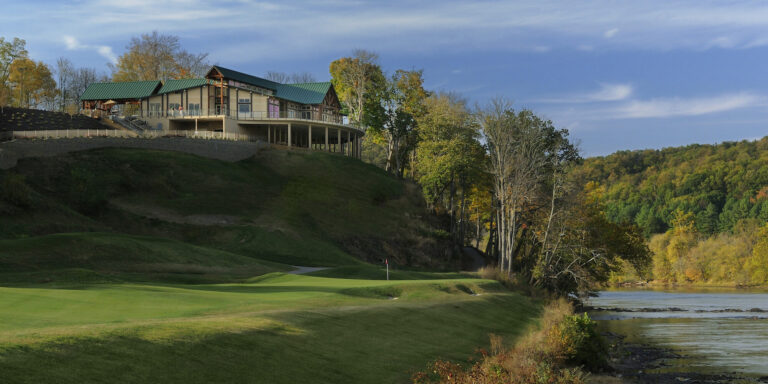With two championship courses and spacious practice facilities, Grandover Resort is a popular venue for high school and college golf teams.
According to Grandover’s director of golf, Jonathan York, several Triad college and high school teams use the facilities.
Leading the list is UNC Greensboro, whose men’s and women’s teams call the resort home. In addition to the expansive outdoor facilities, UNCG has its own indoor facility at the resort, complete with hitting bays, simulators, and a high-tech putting green.
UNCG men’s golf coach Terrance Stewart said Grandover offers various advantages, just a few minutes from campus.
“We have a great partnership with Grandover,” Stewart said. “Our teaching studio has more golf technology than any other spot in North Carolina.”
Grandover also offers different courses.
“The East Course is a beast, very challenging where you fight for pars,” said Stewart. “The West is fun, offering more birdie opportunities.”
In Grandover’s studio, PuttView helps players with speed and line for putts. SAM PuttLab improves their mechanics.
With TrackMan 4, players receive swing data and can play simulated rounds on top courses.
While universities like UNC, Duke, and Campbell have school courses, Stewart said UNCG benefits from Grandover’s facilities and several other public/private courses.
UNCG shares a facility with Precision Golf at Bryan Park, which has two courses.
Other college teams practicing at Grandover include N.C. A&T, Guilford, Greensboro College, High Point, and Winston-Salem State.
Stewart’s teams, dominated by Triad natives, have won three Southern Conference championships and earned seven NCAA Regional at-large bids. Last spring, Kelvin Hernandez (pictured) qualified for the NCAA Championships.
“It’s great we can play different types of courses,” Stewart said. Ø
UNCG golfers practice in their Grandover studio.
Grandover features dramatic stone-lined creeks, and luxury touches with bridges and tunnels.
“That six-week period from July 4 through August 15, with bentgrass, you have to treat it differently,” York explained. “You keep the grass longer, and the greens slower, which makes putting less enjoyable. Now, during the prime golf season from April through October, the greens grow well, and they’re healthy and happy.”
In April, Grandover began removing the bentgrass surfaces, and the greens were sprigged on Memorial Day. Some greens were slightly altered to accommodate the faster speeds allowed by Tif- Eagle Bermuda. Koury construction staff also softened the surfaces, which typically become firmer with Bermuda grass.
The most significant change is at No. 4, where a three-tiered green was converted into two tiers.
The grounds staff took advantage of the course closure to clear out several trees, especially those around greens, to allow more sunlight, which is beneficial for Bermuda grass.
Grandover has filled a void in the Triad since its development over the last three decades. The East Course opened in 1996, followed by the West Course in 1997. The hotel and its facilities opened in 1999.
Though the pro shop is conveniently located in the resort’s main building, and the spacious practice areas are just outside the door, the courses wind through woods, creating a secluded, tranquil atmosphere.
Grandover’s courses and practice facilities are open to both hotel guests and the public. The resort’s Griffin Club loyalty program offers discounts on golf fees, instruction, dining, and spa services.
Packages and outings can also be arranged through the 1,000- room Sheraton Greensboro at Four Seasons and the Holiday Inn Greensboro Coliseum, both also owned by Koury.
As a premier resort — Grandover joined the elite ranks of Wyndham Grand hotels in 2022 — the staff delayed the original opening date to ensure the new putting surfaces were in perfect condition.
Grandover provides rich home facilities for UNCG teams
Grandover reopens West Course with new Bermuda greens
Grandover Resort reopened its West Course with new state- of-the-art Tif-Eagle Bermuda putting surfaces, matching those converted in 2018 on its East
The East Course stretches to 7,213 yards from the back tees, with a challenging 75.7 rating and a 141 slope. It leaves a lasting impression with its 18th hole, a 570- yard par-5 bordered by a lake running down the left side of the fairway and green.
Slightly shorter, the West Course plays at 6,729 yards from the tips with a 72.5 rating and a 136 slope. Its finishing hole is a long par-4 that requires a drive over a deep valley to a plateau fairway, with an approach to a green framed by the hotel.
“It’s a little more generous off the tee,” said director of golf Jonathan York. “People really like the course.”
Both par-72 courses feature large, undulating greens and a variety of bunkers. Carts are equipped with GPS systems that provide shot distances.
The switch to highly heat-tolerant Ultradwarf Bermuda grass should ensure pristine putting conditions year-round, reducing the need for constant hand-watering and large fans.
Over the past two decades, many of North Carolina’s elite courses, including Pinehurst No. 2, Old Town Club, Quail Hollow, and Eagle Point, have converted to newer Bermuda strains. Bentgrass remains dominant only at higher-elevation, cooler mountain courses.
The Triad’s top golf resort, owned, developed, and operated by Greensboro-based Koury Corp., debuted the new greens in August.
A longtime host to many sponsors and players at the annual Wyndham Championship, the 247-room Greensboro resort serves as a convenient meeting and outing destination, located just minutes from Interstates 85, 40, 77, 73, and 74.
The East and West courses, designed by Gary Panks and U.S. Open and PGA Champion David Graham, feature rolling elevation changes and attractively contoured fairways, including dramatic dips, along with beautiful landscaping, scenic water hazards and wetlands, artistic bunkering, and pristine conditioning.
The two layouts boast luxury features such as fountains, stone- lined creeks, custom-made stone and wooden bridges, stone tee signs, wide tunnels under roads, expansive concrete cart paths, and meticulously maintained tee boxes.
“That six-week period from July 4 through August 15, with bentgrass, you have to treat it differently,” York explained. “You keep the grass longer, and the greens slower, which makes putting less enjoyable. Now, during the prime golf season from April through October, the greens grow well, and they’re healthy and happy.”
In April, Grandover began removing the bentgrass surfaces, and the greens were sprigged on Memorial Day. Some greens were slightly altered to accommodate the faster speeds allowed by Tif- Eagle Bermuda. Koury construction staff also softened the surfaces, which typically become firmer with Bermuda grass.
The most significant change is at No. 4, where a three-tiered green was converted into two tiers.
The grounds staff took advantage of the course closure to clear out several trees, especially those around greens, to allow more sunlight, which is beneficial for Bermuda grass.
Grandover has filled a void in the Triad since its development over the last three decades. The East Course opened in 1996, followed by the West Course in 1997. The hotel and its facilities opened in 1999.
Though the pro shop is conveniently located in the resort’s main building, and the spacious practice areas are just outside the door, the courses wind through woods, creating a secluded, tranquil atmosphere.
Grandover’s courses and practice facilities are open to both hotel guests and the public. The resort’s Griffin Club loyalty program offers discounts on golf fees, instruction, dining, and spa services.
Packages and outings can also be arranged through the 1,000- room Sheraton Greensboro at Four Seasons and the Holiday Inn Greensboro Coliseum, both also owned by Koury.
As a premier resort — Grandover joined the elite ranks of Wyndham Grand hotels in 2022 — the staff delayed the original opening date to ensure the new putting surfaces were in perfect condition.
Greensboro National adds upscale services, technology
The changes at Greensboro National Golf Club are noticeable from the moment players enter the parking lot.
Pulling into the lot, players are directed to pull up to the bag drop, where an attendant will take their clubs out of their vehicle and place it on a cart. When players finish their round, their clubs are cleaned and returned to the bag drop. When they’re ready to leave, players pull up to the drop and their clubs are placed inside their vehicle.
The new rule at the Summerfield course is that players don’t have to touch their clubs when not playing the course or practicing on the range or putting green. And the service is complimentary.
That may be business as usual at public and resort courses in Florida, where Greensboro National general manager Bruce Mohler spent decades in the industry. But it’s not the standard in the Triad. And as Mohler noted, it’s not always the standard at well-known regional resorts such as Pinehurst.
“This are was very far behind,” said Mohler. “I don’t know why — I’m not inventing the wheel here.”
Greensboro National has brought a new level of service to public golf in the Triad through technology as well as good old-fashioned manpower.
The more tech changes are also ground-breaking. A new point-of-sale system allows the course to better know its customers. Not only does the club know names, it knows their equipment and clothes preferences, allowing them to sent push notifications when those brands are on sale in the pro shop or when a favorite club maker is coming for a demo day. Customers can also expect to receive a push notification to remind them of their tee time the next day, as well as an annual birthday greeting.
“It’s set up so a public customer can feel like they’re at a private course,” Mohler said.
The GM said providing the upscale service begins with hiring the proper staff.
“I’m a big believer in having people running an operation that feel that this is their livelihood,” he said. “I want people who want to be here.”
What I want hey these guys are here for us.
With the personal information stored in the EZ-GO Pace technology, the pro shop and beverage cart personal know the location of every cart and the players’ names. So beverage cart servers can call their customers by name when greeting them throughout the course.
When players reach the eighth tee, a QSR code appears on the cart’s GPS message board, allowing players to view the grill menu, order food and pay on their phone. The food is placed for pickup on a table just inside the grill on the way to the 10th tee.
There are no long food breaks that so often cause backups on not only the 10th tee, but throughout the course.
While many of the new tech changes benefit the course, they also make rounds much more enjoyable for most of the players. They eliminate annoying waits on the tees and keep rounds moving smoothly. For example, Mohler said that despite a filled tee sheet with 260 players — the overwhelming majority playing in foursomes — on Labor Day, the average round finished in 4 hours, 16 minutes, a real accomplishment on a busy holiday when players of varying skill levels and experience hit the course.
With the PACE system, Mohler said at least half a dozen staffers at any time can pinpoint every group on the course and ensure pace of play is maintained without logjams.
“It’s gone very well,” Mohler said of customer response. “They like the high service of it.”
But Mohler said the changes weren’t made solely to raise revenues by playing more rounds each day. In fact, Mohler said tee times, which had previously been as little as seven minutes apart, are now separated by either 9 or 10 minutes to give players less waiting time and a more relaxed atmosphere.
As another example of new benefits given to players, Greensboro National supplied free water bottles in their carts’ mini coolers during summer months.
Virginia Tech’s scenic River Course worthy of drive
As a name, The Pete Dye River Course of Virginia Tech pretty much says it all about the home course of the Hokies golf teams.
The famous – or infamous — Pete Dye was the designer and the course is vintage Dye with a diversity of holes and greens complexes, including pot bunkers, that have made him famous through renowned courses such at TPC Sawgrass, the Ocean Course at Kiawah Island, Harbour Town and of course, The Cardinal by Pete Dye in Greensboro.
The course, which opened in 2006 in Radford, Virginia, about 11 miles from Virginia Tech and a 45-minute drive from Roanoke, is owned by the Virginia Tech Foundation, though managed by McConnell Golf of Raleigh, whose portfolio also includes Sedgefield Country Club, The Cardinal and Old North State Club in the Triad. The foundation bought the course, then home to a more modest layout, and turned it over to Dye, who changed much of bunkering and some of the routing.
Then there’s the New River, which runs along a dozen holes, serving as a lateral hazard while supplying consistent spectacular views of the roaring, wide channel and the magnificent bluffs on the other side. The layout, a links course bordered by a large river rather than an ocean, with sand and natural areas — not trees — lining the fairways and bordering the river.
PGA General Manager Michael Abraham said Dye also eliminated many trees, giving the course a “links” feel and more scenic views of the river.
“I was told that Pete Dye said, ‘I envision this as a links-style course,” Abraham said. “If somebody who played the course before Dye made the changes, they would probably feel like they were on a different course.”
Though located in the foothills of the Blue Ridge Mountains, the River Course sits in the valley, stretching along 2.5 miles on the West Bank of the twisting New River. The clubhouse offers a magnificent view from a perch on the western cliffs.
The course is open to the public. Somewhat remote, the River Course is about 1 hour, 45 minutes from Winston-Salem and 2:15 from Greensboro via U.S. 52 and Interstates 77 and 81.
Dye provided the VT Foundation with a course long and tough enough for top competition but manageable for children and high-handicappers, too. Summer rates are $56 on weekdays and $71 on weekends. Memberships, some with privileges at other McConnell courses, are available.
The course is extremely walkable with no major climbs or long treks between greens and tees.
“It is probably the flattest golf course in the Roanoke-New River Valley area,” Abraham said.
Facilities include practice range and putting green. Preston’s on the River, a full-scale restaurant and bar, is open six days per week, and features a patio looking down over the final hole, the river and the cliffs on the other side.
From the tips, the par-72 course measures 7,685 yards with a 77.3 rating and 145 slope, with other tees playing 7,088, 6,495, 5,903, 5,142, 4,606 and 3,881 yards. Abraham said the commonly played tees are the 6,495-yard Orange, a stiff challenge with a 71.9 rating and a 134 slope.
“We do an annual SWAT analysis and usually the No. 1 threat is how hard our course is,” said Abraham. “We’ve tried to embrace that. We admit we’re tough, but we have different tees.”
Last year, the 4,606-yard yellow set of tees was added, quickly becoming a favorite of many women players.
An example of the course’s versatility and balance, each of the four par-3s play in different directions — north, south, east and west — and important feature considering the typically significant winds off the river. The front and back sides each have one long and one short par-3 hole.
Abraham said the course offers steady winds, sometimes with gusts of 20-25 mph.
The bent grass greens are typically perched with the edges rolling down though extended, tightly mowed collars into a variety of traditional bunkers, pots and grassy swales, requiring skilled chips and pitches. With as much as 10 yards of collar around some greens, players often have the option of putting, though often that requires a firm strike uphill to the speedy, undulating putting surfaces, which typically range in size depending on the expected approach.
The course’s four par-5s are the top handicap holes. Often fairway sand, pots and natural areas encroach on fairways forcing well struck shots to set up an approach.
Players get an early impression of what’s in store upon arrival in the pro shop, which looks down 75 feet from a cliff to No. 18, a long par-4 stretching along the river.
Old Town gives Wake Forest nation’s actual No. 1 ‘college’ course
There’s only one reason Old Town Club, home course of the Wake Forest University golf teams since the campus relocated to Winston-Salem almost seven decades ago, isn’t “officially” regarded as the nation’s top collegiate golf course.
Though the club has several ties to the university, dating back to the ownership of the property, Old Town isn’t a “college course”. It’s a private club with a history intertwined with the university. In fact, until 1968, Wake students and faculty could play the course for $1. Regardless, the several media sources that have ranked college courses in recent years, disqualify Old Town for consideration.
No other college golf team has a comparable course to call home. A classic design by heralded Depression-era architect Perry Maxwell, the layout has enjoyed a spurt of increasing appreciation over the past decade since renovations by the celebrated team of Bill Coore (a Wake alum) and Ben Crenshaw, becoming a consensus top 100 U.S. course in rankings compiled by major magazines.
For example, Golf Magazine ranked Old Town No. 38 among U.S. courses and No. 84 in the world in 2023. Also last year, Golf Digest listed Old Town No. 54 in its U.S. rankings. No “college” course is on those lists.
The 2013 changes included the removal of many trees, creating stunning views of the entire property and making it possible to maintain firm turf conditions, as well as a redesign of bunkers that brought them more into play while giving them a more artistic, natural look, often surrounded by natural vegetation. The greens also were expanded more than 30% to a total of about 110,000 square feet, bringing them close to Maxwell’s original sizes and bringing them closer to the bunkers.
“It has really shot us up all the charts,” Dunlop White, Old Town’s golf chairman, said of the Coore and Crenshaw renovations. “We have catapulted up not only all the lists, but we seem to be on everybody’s radar, too. The changes were very transformative. I can’t believe how far the bar has been raised.”
Old Town remains very much an integral part of Wake golf, a major enticement to many of the nation’s top golf recruits. Almost adjacent to the campus and only a short golf cart ride away for men’s coach Jerry Haas and women’s coach Kim Lewellen, and a few minutes by car for their players, the course has a strong Wake Forest presence — from the many alumni members to the portrait gallery of former Wake greats such as Arnold Palmer in the venerable brick clubhouse.
On the eve of the recent Wyndham Championship, Will Zalatoris, the latest Wake golfers to become a standout on the PGA Tour, returned to Old Town to catch up with former teammates and men’s coach Jerry Haas.
“The whole membership has been awesome to the team,” said Zalatoris, a few days before the start of the Wyndham. “They treated us like members. There was no time we couldn’t play, including Mondays.”
Though Wake has a 17-acre, state-of-the-art indoor/outdoor practice facility on campus, Demon Deacon golfers enjoy that continuous access to the Old Town course, which is not only revered for its classic routing and meticulous grooming, but its rolling topography that forces players to hit shots from all types of uneven lies.
Maxwell’s other heralded designs included Southern Hills and Prairie Dunes. He also made significant improvements to Augusta National following the death of his former design partner Alister MacKenzie. For the design at Old Town, Maxwell had his choice of 165 acres out of the more than 1,000 acres or so offered by Charles and Mary Reynolds Babcock for the new Wake campus and surroundings.
Old Town has a distinctive open look with continuous fairway grass (estimated at 80 acres), connecting several holes and providing scenic vistas over much of the course, which makes good use of Silas Creek on several holes.
The markers in the open tee areas can be adjusted to create significantly differently angles of attack. Red flags mark the front nine pins, yellow identify the back nine pins – important to note because a sprawling, double green serves Nos. 8 and 17.
Though the wide fairways and lack of heavy rough seem inviting off the tees, precision is required to obtain proper angles and ideal lies to attack the pins.
The undulating greens, converted to Tif-Eagle Bermuda last year from bent grass, feature trademark “Maxwell rolls,” small rises sometimes described as “muffins” that require precise putting to properly navigate. Most of the putting surfaces include two or three of these rolls, making them an important factor on approach shots.
“Old Town is very wide open, but the greens are very severe,” said Zalatoris, who stressed the importance of placing tee shots to allow favorable angles for approaches.
Many subtle touches add to enjoyment of the course. No cart paths line the fairways, eliminating bad bounces into trouble areas. Flags on the pins are yellow on the front nine and red on the back, important to note considering the double green. Pin sheets with exact yardage are provided.
Coore and Crenshaw, keeping with their natural, minimalistic phi, acquired Yadkin River brown sand for the bunkers.
“it’s now all about coordinating maintenance with design,” White said, “Most design improvements are in the rearview mirror.”
White said that future plans for the course may include expanding the greens to 115,000 SF, which he said would approximate the original sizes.
From arrival, the experience at Old Town is unique.
The small golf pro shop is behind the impressive brick clubhouse, leaving a short walk through a courtyard flanked by the open teeing areas for Nos. 1 and 10. The casual openness of the courtyard and the flat, non-distinctive teeing areas make for a striking introduction. There are no tee times – just wait your turn in the courtyard and tee off when the fairway is clear.
The routing includes an opening three-hole south loop that leads back near the clubhouse to No. 4, where “The Big Reveal” from the fairway hill provides a view of much of the property. On the back nine, a spectacular, panoramic view back toward the clubhouse can be viewed from the volcano-shaped 16th green.
The most memorable holes include No. 5, a sharp dogleg left par-4 with a largely blind uphill tee shot, and 14, a short par-4 reachable off the tee for the biggest of hitters willing to risk bogey or worse to a fairway and green that slope perilously left toward the creek.
Of course, the par-4 8th and par-5 17th are the signature spots, featuring a double green running along the creek where the pins are typically more than 200 feet apart.
The blind tee shot at 8 travels down a vast fairway sloping toward water on the right with the vast double green a mostly horizontal target. From the right side of the fairway, the red flag is positioned on the left side of the putting surface, leaving players with the unique position of aiming away from the closest pin in their approach over the creek.
At 17, the second shot should be to the lower right side of the fairway, leaving a flatter lie for a short approach over creek to a smaller portion of the green guarded in front by the creek and a small bunker.
Old Town finishes with an uphill, par-4 to a green flanked by the clubhouse.
High Meadows provides beauty, challenge in relaxed atmosphere
As a mountain golf retreat, High Meadows Country Club pretty much has it all, yet its relaxed vibe makes it a relative secret in the N.C. High Country.
Start with the setting in spectacular, yet remote Roaring Gap, a beautiful getaway accessible only via a twisting two-lane road, half and hour from an interstate. Then there’s the club’s George Cobb layout that winds over and through hills and valleys, pristine streams, ponds and lakes, offering a stiff challenge without the likelihood of losing a dozen golf balls in the process.
The mountain-themed clubhouse features fine dining in one formal room overlooking the course and a more casual atmosphere in another separate room, also with a view of the 18th hole, which finishes along a lovely, trout-stocked lake. Perhaps best for a post-round sandwich is a comfy downstairs grill room.
Late this year, the club will open a new indoor-outdoor facility at the practice area, allowing golfers to work on their game regardless the weather conditions. Members will be able hit out from heated bays that can also be closed and used with simulators.
That’s right, High Meadows is one of the few N.C. mountain clubs to keep its golf course open year-round. The club also has the requisite fitness, pickle ball, tennis and swimming facilities. The dining and activity amenities are especially important considering Roaring Gap consists of a historic church, three golf clubs and large overgrown convenience store.
Founded in 1964, at about 3,000-foot elevation, High Meadows blends in nicely with its surrounding community, which includes many residents making it their primary residence.
In recent months, the club is emerging from its leafy shadows with a new vibe creating more activity at the club while maintaining the tranquility cherished by its members.
High Meadows aims to recruit new members to a club that was already surprising affordable with initiation and fees far below comparable upscale exclusive golf clubs in the Triad, Raleigh, Durham, Asheville, Wilmington and Charlotte. For members living 35 miles or more away, the costs are competitive with many semi-private clubs.
In 2024, High Meadows’ new vibe gained notice with the hiring as club professional of longtime Old Town Club staffer Tommy Gibson, the 2021 and 2022 Carolinas PGA Player of the Year.
Robin O’Neil came to the club after several years at Hilton Head Island-area clubs as general manager during the summer. O’Neil is overseeing creation of a new casual dining room and added food and beverage options, driving membership, marketing and facility maintenance and making property enhancements.
O’Neil credits superintendent Jordan Harris, a former assistant at Sedgefield and Primland for maintaining the course’s pristine conditions.
Gibson quickly upgraded the pro shop layout, added new merchandise and equipment and designed a new club logo.
Still, the course remains the showpiece, beginning with the fun, creative design by Cobb, whose portfolio includes Quail Hollow and the par-3 course at Augusta National.
From the back tees, High Meadows is a stiff test of 6,700 yards with several dramatic elevation rises and drops leading to a 72.1 rating and 130 slope. But with five other sets of tees — the front markers measuring just 3,970 yards — the course is playable for scratch players and high-handicappers alike. Only two dozen or so bunkers come into play, but serve strategic purposes.
The greens, a mix of bent and Poa annua that has flourished over the years, range in variety and size, and run true and fast with care taken to avoid impossible to stop downhill putts. The ample fairways, lined by dense trees are divided vertically in color with a “European” style mowing pattern. Several trees were recently trimmed to provide more shot options and sunlight to the fairways.
One of the most unique shots comes at the par-3 11th, which features a dramatic uphill shot to a large green, all but the pin hidden from view on the tee. From the 186-yard tips or 168-yard white tees, the shot can require a long iron then a moment of suspense on the drive to the putting surface.
At 12, a par-5 stretching to 495 yards, players are treated to a spectacular approach to a green with the property’s largest lake serving as the backdrop framed by woods on either side.
No hole may be as fun as the par-4 No. 13, where a good drive carries a plateau and cascades down a steep grade, leaving only a wedge to a small green protected by two bunkers with a pond on the right with U.S. 21 in the distance.
The finishing hole, a 497-yard par-5, features two small lakes, one to the right, coming into play mostly on the second shot; and another to the left, grabbing errant second shots as well as protecting the green on approaches. From the clubhouse deck atop a hill to the right of the green, members can watch players conclude their round in a beautiful setting.
Highlights on the front nine include the 427-yard par-4 sixth, where drives must be accurate to avoid fairway bunkers on both sides with the approach turning slightly left to a small green.
At No. 9, only 333 yards from the tips, big hitters can go for the green off the tee with a required fade, though two small lakes to the left of the green — directly straight from the tee — and dense woods to the right, make double-bogeys common for gamblers.
Hernandez earns medalist honors as UNCG wins at Bryan Park
Kelvin Hernandez took medalist honors as UNC Greensboro won the Bryan National Collegiate tournament Tuesday at Bryan Park Champions course.
Hernandez, a sophomore, shot rounds of 68, 69 and 71 to finish at 8-under-par 208. The Spartans, who also won the event last year, shot 10-under 854 to beat Delaware by two strokes. Boston College was third at 862.
The victory was the first for Hernandez (pictured) in his UNCG career. The Puerto Rico native became the first first UNCG player to qualify for the NCAA Championship last spring.
B.J. Boyce, who shot 66 in the opening round, tied for eighth at 213.
Lincoln Newton adds another summer CGA title
Lincoln Newton of Wallburg continued his winning summer, posting a 6-under-par 134 total Sunday to win the Mimosa Hills Junior Invitational in Morganton by one stroke over James Rhodes of Columbia, South Carolina.
Newton shot 68 in the final round at Mimosa Hills Country Club, including a birdie on No. 16 that proved to be the difference. Rhodes birdied No. 17 to pull within one shot.
In the past six weeks, the 16-year-old Newton, who attends Oak Grove High, also has won the High Point Junior, the CGA Father-Son, the Triad Amateur. Newton birdied the first two holes Sunday during a round of three birdies and only one bogey.
Sanaa Carter of Jacksonville won an eight-hole playoff with MacKenzie Cline of Cary for the Girls’ title after posting 149, including 74 in the final round. The field consisted of 99 boys and 24 girls.
Sam Terry of Thomasville tied for 12th in the Boys’ division at 139. No Triad girls participated.
Barry rallies at Old Town to win Forsyth Amateur
Brett Barry of Winston-Salem shot even-par 70 at Old Town Club on Aug. 18 to win the Forsyth Amateur with a 5-under-par 212 total, two shots ahead of James Glenn.
Barry, a former player at Union University in Jackson, Tennessee, rallied from four shots behind entering the final round. The first two rounds were held at Reynolds Park and Pine Knolls before the field was cut to 16 players.
Wyndham Championship keeps its position on PGA Tour
The Wyndham Championship remains as the PGA Tour’s last regular-season tournament on its 2025 schedule.
The tournament at Sedgefield Country Club will be contested July 31-Aug. 3, according to a release by the PGA Tour. Aaron Rai won the 2024 tournament last week, earning the $1.422 million first prize.
Wyndham will follow the 3M Open in Minnesota. The first playoff tournament begins Aug. 7 in Memphis. Wyndham has a contract as title sponsor of the Greensboro tournament through 2026.










